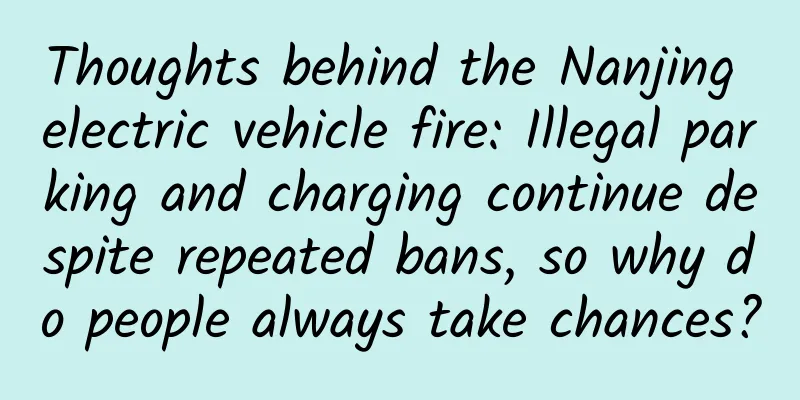Thoughts behind the Nanjing electric vehicle fire: Illegal parking and charging continue despite repeated bans, so why do people always take chances?

|
The fire in a residential building in Nanjing caused heavy casualties. It is reported that the fire spread from the parking area of electric bicycles (hereinafter referred to as battery bicycles) on the first floor, which was most likely caused by improper charging of battery bicycles. After the accident, several popular science publications published articles about the dangers of charging electric bicycles indoors, and relevant departments also quickly launched community fire safety inspections. The science popularization media promptly followed up on major accidents and provided popular science information, which is certainly worthy of high praise. In addition to reminding the public, science popularization accounts use hot topics to enhance their influence, which is also the only choice to actively combine their own marketing with the popularization of hot science knowledge. Compared with issuing public service advertisements warning against improper charging of electric bikes in many public places, there is no doubt that timely popularizing relevant science during hot events will greatly increase readers' attention and make readers more vigilant about it. This is also an important function of emergency science popularization or risk communication. However, if we want to consider the effect of risk communication, that is, to make people actually give up or reduce charging their electric vehicles in residential buildings, we need to explore the psychological cognition of the public more comprehensively. Of course, the relevant departments should also strengthen the supply of electric vehicle charging piles in public places and promote the convenient use of charging piles. Why face possible risks? People always have a sense of luck? Risk communication is a research field that has developed since World War II with the rapid development of science and technology and its increasing impact on society. This field aims to enable the public to form a reasonable understanding of potential risk technologies such as nuclear power and genetic modification based on risk-benefit trade-offs, and actively avoid behaviors such as smoking and bad driving habits that are harmful to health and public safety. After a long period of exploration, since the 1990s, risk communication has gradually shifted from emphasizing the provision of correct risk knowledge and accurate risk information to paying more attention to the public's risk perception and the cognitive laws behind it. Applying a large number of repeatedly verified theories in risk communication to areas such as improper charging of electric vehicles can give us more understanding and feasible measures on how to improve charging safety. Risk communication research over the years has found that while it is important to provide the public with correct knowledge, we should also pay attention to the following questions: Does the public pay attention to relevant popular science information? To what extent do people adopt this information when taking actions? How does this information interact with risk factors to form behavioral decisions? Scholars have widely noticed that correct knowledge itself is unlikely to be a driving force for people to avoid risk. Some scholars have found that people always have an unrealistic optimism and fluke mentality, that is, they always believe that others are more likely to encounter specific risks than themselves, so they can continue to engage in these risky behaviors. Copyright images in the gallery. Reprinting and using them may lead to copyright disputes. In terms of charging electric bikes indoors, this finding can be summarized as follows: although people are clearly aware that charging electric bikes indoors may pose a safety hazard, they always think that it is the business of other people and other corridors. In fact, this unrealistic optimism is rooted in a basic bias in our human cognition, the so-called third-person effect. This bias always believes that one's own understanding is more correct than others, with fewer mistakes and fewer prejudices. It is not a negative word to say that it is a bias. As long as we are human, we will always have various biases. Not only that, people also have a risk compensation psychology . A large number of studies have shown that after laws require drivers to wear seat belts before traveling, the average driving speed of many drivers will increase; after cyclists wear helmets, they will generally ride faster. Although there is no research on electric vehicle charging, based on past results, we can speculate that when people realize that the safety performance of electric vehicle charging has been improved, they will tend to adopt more irregular or potentially risky charging behaviors. Copyright images in the gallery. Reprinting and using them may lead to copyright disputes. In terms of information adoption, a large number of studies in recent years have also shown that people always give priority to information that is more consistent with their own values and behavioral habits. But why do people ignore or neglect those good medicines that are bitter but beneficial to the disease and bitter taste? We may take it for granted that this is because people have bad habits. However, research in the past decade or so has shown that although people have access to a great deal of information, their own cognitive abilities have not improved. Therefore , they often rely on behavioral habits and environmental cues to prioritize the information that they are most familiar with or that is least contradictory to their own cognition. Moreover, the normal way of thinking of human beings is to avoid using their own cognitive resources in the absence of stimulation, which is the way of treating information "without thinking" which is usually a bit derogatory. Although "without thinking" is a derogatory term in our daily context, it is just the most normal behavioral response when applied to human cognitive behavior. How to slow down people's Risky behavior? In this case, is there any way for us to stop or at least slow down people's risky behavior? The answer is yes. Applying these studies to the potential risk of improper battery charging, we first find that although popular science articles, special safety manuals, official websites, and some road sign public service advertisements will publish warnings about improper battery charging , reminding people not to charge indoors by themselves, such information coverage is too small, especially far away from the places where people actually do this, such as residential building corridors or overhead floors where battery batteries are stored . Most people will not think about the warnings about improper charging in the public service advertisements they have seen when parking to charge . So will it work if we post such warning signs in the corridor? Not completely. It also depends on how they attract our attention and how they affect our decision-making process after attracting our attention. For the former, what we need to do is not only to post a sign there, but also to ensure that it is eye-catching, easy to see, catchy and easy to understand. In recent years, a large number of studies have shown that visual stimulation is stronger than simple text stimulation. This is because research has increasingly revealed that people's cognition and decision-making processes are not necessarily based on rationality (usually relying on text symbols and text meanings), but rather rely on cognitive shortcuts that are less "brain-intensive". This is the principle that pictures or videos often have a better persuasive effect. Copyright images in the gallery. Reprinting and using them may lead to copyright disputes. The study also found that negative statements are stronger than positive statements. Although the research on the greater cognitive effect of negative statements has only been discovered in the last two or three decades, it is actually rooted in a basic principle of human cognition, that is, the negative tendency based on the limited information processing ability. Our inability to process the large amount of information in the environment did not begin in today's digital age. In fact, our primitive ancestors already had a lot of environmental risk information to process. Therefore, it is easier to avoid risks by prioritizing negative information (that is, information that goes against people's long-term habits). For example, if a large number of fallen grass is found in a certain area, it may be a sign of wild animals. Compared with normal grass, fallen grass is a typical negative feature. People will deal with it first and are more likely to avoid risks. This basic cognitive tendency is also the reason why negative media reports tend to attract more attention. Here we can also add a common communication theory applied to behavioral persuasion, that is, cognitive dissonance theory. When people encounter cognitive dissonance (of course, the premise is that the relevant information has attracted people's attention), they will try to avoid this dissonance, or avoid information, or when the information cannot be avoided, they will think of changing their behavior. The most common occasion for cognitive dissonance theory is public service advertisements for quitting smoking and drinking. The image of a cigarette with a lung burned by tobacco is an image that many of us have seen. For those who have a fluke mentality What should we do? What should we do about those who think that other people and other corridors are at greater risk, so I can continue to charge without worry? One solution is to provide comparable numbers , such as absolute numbers, rather than simple warnings, such as charging indoors, you have a certain chance of dying in a fire accident. However, absolute numbers may still make some people feel that it is none of their business. Then the relative probability is a more intimidating statement . For example, if you charge your battery indoors, your chance of losing it in a fire will increase several times compared to not charging it (pending professional research and estimation), although in terms of absolute numbers, the probability is still quite low. From the perspective of public safety or risk prevention management, these practices do not actually increase costs much. But they actually represent a shift in management style, from focusing on public announcements to paying more attention to the impact and interference on individual citizens' attitudes and behaviors. my country has widely adopted this model in the field of public health, especially in health education on quitting smoking and drinking. Copyright images in the gallery. Reprinting and using them may lead to copyright disputes. Of course, for some understandable reasons, we are still not doing enough in this regard. For example, on cigarette boxes, there is only one line of words written: "Smoking is harmful to health", but no mention of how harmful it is. Recently, I noticed that the line of words has even changed to "Smoking is harmful to the health of teenagers", as if adults are safe. Even so, influencing individual attitudes and then interfering with their behavior has become a common practice in many public health affairs in our country. However, in the field of public safety, even if it is still related to individual health, this practice is not common. For example, in many countries, anti-drug information is widely publicized in the form of presenting the harm of drugs to personal physical and mental health, using various communication models we introduced above. But in the streets and alleys of China, anti-drug information is often announced in the form of the harm of drugs to society and the country's severe crackdown on drug prohibition. The national conditions are different, so of course we cannot copy the practices of other countries. However, for those adverse consequences mainly caused by individual spontaneous behavior, it is an effective measure to study the theory and excellent practices of risk communication in depth, popularize them in combination with China's national conditions (such as sound grassroots community organizations), and finally form reminders and interference in individual behavior. Planning and production Author: Jia Hepeng, Professor and Doctoral Supervisor, School of Media, Soochow University Reviewer: Fan Chunlei, Associate Researcher, Institute of Psychology, Chinese Academy of Sciences Planning丨Xu Lai Editor: Wang Mengru Proofread by Xu Lailinlin |
<<: All kinds of bizarre biological lamps, the earth's "original" lighting technology!
Recommend
A rough man enjoys exercising and losing weight
A brief introduction to Yijieren Yuelian Yueshou ...
China Unicom's 4G strategy confirmed: centralized operation and control of marketing in various regions
At the recent China Unicom Dual 4G Leading Plan I...
An inventory of the best value-for-money headphones at the end of the year: Which would you choose, WF-SP800N or Powerbeats Pro?
In recent years, "true wireless" headph...
Advanced Software Test: System Architecture Designer Elite Class 2022 5th
Course Catalog ├──1–Understanding Cognition (Pre-c...
The Hotan-Ruoqiang Railway officially opens to traffic today, encircling the Taklimakan Desert
June 16 Hotan-Ruoqiang Railway (hereinafter refer...
How to do 315 crisis public relations?
Tomorrow, CCTV’s annual “selecting troops and gen...
A set of Excel animation tutorials worth 8800 yuan
For professionals, Excel is one of the software t...
In Xinjiang, I saw the legend of "a thousand years of standing"
On the shore of Lop Nur Lake in Xinjiang Uygur Au...
How does the gyroscope that is indispensable to smartphones work?
If you place a spinning top on a table, it will f...
Why can't you always catch the doll? The mechanical secrets of the claw machine
Claw machines, a game device full of fun and chal...
【Wanbo Brothers】An Initial Study on the Basics of Wanbo Brothers' Price Comparison 1 PDF Article
【Wanbo Brothers】An Initial Study on the Basics of...
LeTV launches a super combination punch to impact traditional e-commerce festivals
TVs are reduced by 500 yuan, mobile phones are re...
Tik Tok product analysis report!
Tik Tok ’s functions are becoming more and more d...
Are Douyin sales calculated on a monthly basis? How to increase sales on Tik Tok?
This article mainly introduces whether Douyin sal...
The wild vegetable season is here again. Poetry and ancient prose will help you appreciate the history of wild vegetable consumption
Spring is the season for all things to grow, and ...









